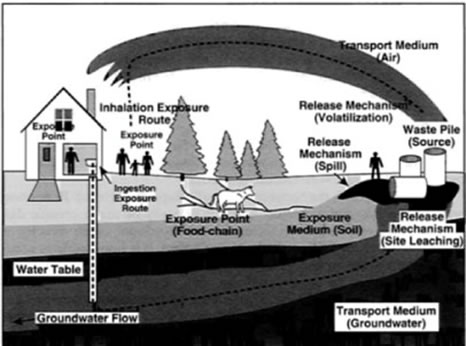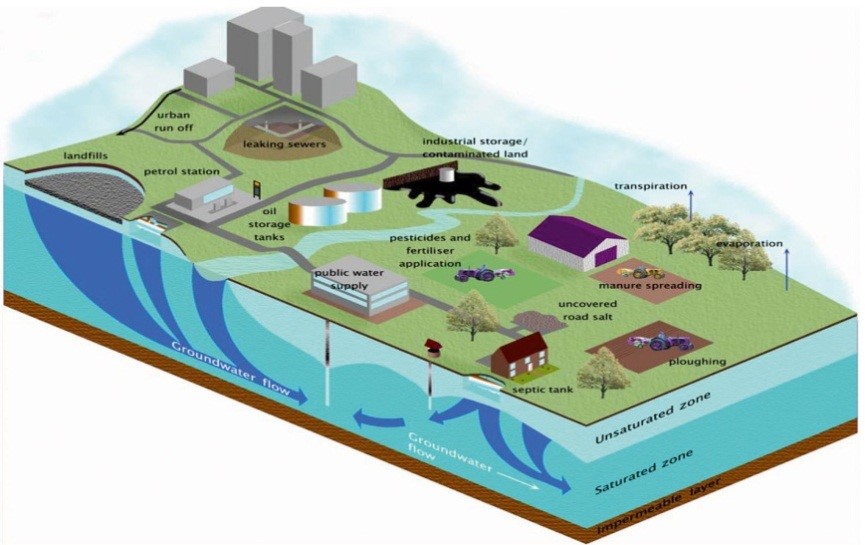Online Undergraduate Course
Nurs 467 - Public Health Nursing
Module 11: Environmental Health and Emergency Preparedness
EH RISKS AT HOME, WORK, AND IN THE COMMUNITY
The Basics
Environmental hazards may be encountered at home, at work or school, or in the community via several pathways: contaminated air, soil, water, food and other products (see Figure 2.1). Routes of exposure include:
- inhalation (i.e. dust or fumes)
- ingestion (i.e. pesticide residues on produce or lead in drinking water)
- dermal absorption (i.e. ultraviolet-B radiation from the sun or direct skin contact with caustic household cleansers.
Exposure to an environmental hazard does not necessarily mean that human health is affected. Organ and tissue damage depends on many factors, including:
- dose of the hazard – this is the primary factor that indicates whether a hazard is harmful; "the dose makes the poison"; higher doses often cause more harm but not always
- timing of the exposure – critical windows exist (in utero, puberty) when exposure results in greater harm than at other times
- frequency of exposure – a one-time exposure or repeated over time
- length of exposure – longer duration often means worse outcomes

FIGURE2.1 Exposure pathways. SOURCE: ATSDR, 1992.
Home
The home environment may contain multiple and various environmental threats to health. Some well-known examples include pesticide residue on food, contaminated drinking water, carbon monoxide, radon, and lead paint. Lesser known hazards include chemicals in cleaning products and personal care products, and chemicals that are off-gassing from new furniture and carpet. Many of these chemicals have never undergone any testing for health effects but are allowed to be used in the US regardless. Other countries that subscribe more fully to the Precautionary Principle have banned certain chemicals from foods and cosmetics.
Workplace Safety
Top Workplace Hazards
Although it is difficult to pinpoint exactly which workplace hazards present the most danger to workers as a whole, the CDC’s National Institute for Occupational Safety and Health have outlined some of the most common workplace hazards and exposures that frequently lead to various types of occupational injuries and illnesses and often result in workers' compensation claims.
Employers and employees alike have roles to play in workplace environmental safety. Although specific safety procedures will vary from industry to industry and worksite to worksite, there are some general guidelines that exist. Many of these guidelines were developed under the Occupational Safety and Health Act (OSHA). This legislation requires employers to provide a safe workplace for all employees. For example, people that work with potentially hazardous materials have the right to know what they may be exposed to. Therefore, employers are required by law to ensure that chemicals are labeled appropriately and accompanied by a Safety Data Sheet (formerly called Material Safety Data Sheet) that outlines important information. Employees are responsible for reading the information, participating in training, and following recommendations or requirements related to personal protective gear. Click here to read about Safety Data Sheets (scroll down to the bottom to see the Employer Responsibilities). Do you know where the Safety Data Sheets are kept in your hospital or place of employment?
Hazards in the Nursing Workplace
Nurses often face unique hazards at work, including chemical exposures, exposures to anesthetic gasses, and radiation. Click here to use the interactive tool to identify occupational hazards specific to each area of the hospital environment. What should you be looking out for, based on your unit and job function?
Community
Clean air and water are critical to our health. The air, groundwater and soil can easily become contaminated from heavy metals, pesticide runoff, exhaust, spills, and other threats, including industrial practices like “fracking”.

The day of the Solvay chemical leak started like any other day for staff and students at the Curtis Bay Elementary/Middle School. When the shelter-in-place recommendation was sent out to community members, the school reacted quickly, however, staff soon realized that improvements needed to be made to their emergency plans. Watch a discussion between the school nurse and the principal a few days after the leak.
Environmental Justice
“Environmental Justice is the fair treatment and meaningful involvement of all people regardless of race, color, national origin, or income with respect to ... environmental laws, regulations, and policies. It will be achieved when everyone enjoys the same degree of protection from environmental health hazards and equal access to the decision-making to have a healthy environment in which to live, learn, and work” (EPA, 2022)
Often times, communities with few resources are burdened with an increase in environmental exposures because they don’t have the capacity to develop and implement an effective oppositional campaign.
Consider Curtis Bay. In Module 3, you identified tremendous needs in the community related to the environment, but you also pointed out some valuable resources. We met some strong, dedicated residents and other stakeholders that were determined to see that environmental justice was present in Curtis Bay, as related to the proposed incinerator.
This website is maintained by the University of Maryland School of Nursing (UMSON) Office of Learning Technologies. The UMSON logo and all other contents of this website are the sole property of UMSON and may not be used for any purpose without prior written consent. Links to other websites do not constitute or imply an endorsement of those sites, their content, or their products and services. Please send comments, corrections, and link improvements to online@son.umaryland.edu.